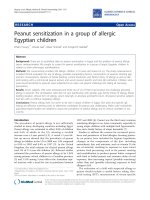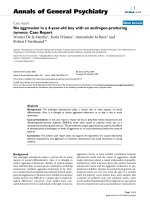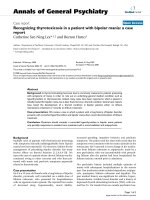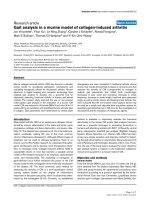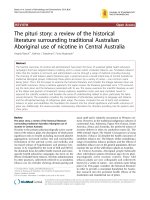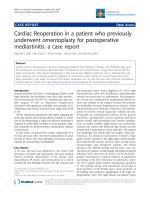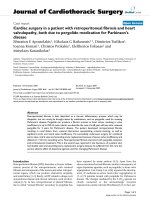Báo cáo y học: "Peanut sensitization in a group of allergic Egyptian children" pptx
Bạn đang xem bản rút gọn của tài liệu. Xem và tải ngay bản đầy đủ của tài liệu tại đây (256.58 KB, 6 trang )
RESEARCH Open Access
Peanut sensitization in a group of allergic
Egyptian children
Elham Hossny
1*
, Ghada Gad
1
, Abeer Shehab
2
and Amgad El-Haddad
3
Abstract
Background: There are no published data on peanut sensitization in Egypt and the problem of peanut allergy
seems underestimated. We sought to screen for peanut sensitization in a group of atopic Egyptian children in
relation to their phenotypic manifestations.
Methods: We consecutively enrolled 100 allergic children; 2-10 years old (mean 6.5 yr). The study measurements
included clinical evaluation for site of allergy, possible precipitating factors, consumption of peanuts (starting age
and last consumption), dur ation of breast feeding, current treatment, and family history of allergy as well as skin
prick testing with a commercial peanut extract, and serum peanut specific and total IgE estimation. Children who
were found sensitiz ed to peanuts were subjected to an open oral peanut challenge test taking all necessary
precautions.
Results: Seven subjects (7%) were sensitized and three out of six of them had positive oral challenge denoting
allergy to peanuts. The sensitization rates did not vary significantly with gender, age, family history of allergy, breast
feeding duration, clinical form of allergy, serum total IgE, or absolute eosinophil count. All peanut sensitive subjects
had skin with or without respiratory allergy.
Conclusions: Peanut allergy does not seem to be rare in atopic children in Egypt. Skin prick and specific IgE
testing are effective screening tools to determine candidates for peanut oral challenging. Wider scale multicenter
population-based studies are needed to assess the prevalence of peanut allergy and its clinical correlates in our
country.
Introduction
The prevalence of peanut allergy is not sufficiently
studied in many developing countries including Egypt.
Peanut allergy was estimated to affect 0.8% of children
and 0.6% of adults in the US, showing a twofold
increase over a 5-year period [1,2]. A recent 11 year fol-
low up survey showed that the prevalence of peanut
allergy in children in the US in 2008 was 1.4% compared
to 0.8% in 2002 and 0.4% in 1997 [3]. In the United
Kingdom, the total estimate for clinical peanut allergy
was1.5% of 3-4 year-old children [4]. Relevant studies
estimated the prevalence of peanut allergy to be 1.34%
among primary school children in a Canadian province
[5] and 1.15% among 3 year olds in the Australian capi-
tal territory with a trend for rise in prevalence between
1997 and 200 5 [6]. Peanut was the third most common
sensitizing allergen in an Asian community especially in
young atopic children with multiple food hypersensitiv-
ities and a family history of atopic dermatitis [7].
Studies to address the reasons for increased preva-
lence and persistence of food allergies, focusing primar-
ily on peanut, h ave included the hygiene hypothesis;
changes in the components of the diet, including
antioxidants, fats, and nutrients, such as vitamin D; the
use of antacids, r esulting in exposure to more intact
protein; food processing, such as for peanut roasting
and emulsification to produce peanut butter compared
with fried o r boiled peanut; and extensive delay of oral
exposure, thus increasing topical (possibly sensitizing)
rather than oral (possibly tolerizing) exposure to food
allergens [8,9].
The evaluation of a child with suspected allergy to
peanut should include a careful history taking, skin-
prick testing (SPT), measurement of serum-specific
* Correspondence:
1
Departments of Pediatrics, Ain Shams University, Ramses Street, Cairo 11566,
Egypt
Full list of author information is available at the end of the article
Hossny et al. Allergy, Asthma & Clinical Immunology 2011, 7:11
/>ALLERGY, ASTHMA & CLINICAL
IMMUNOLOGY
© 2011 Hossny et al; licensee BioMed Central Ltd. This is an Open Access article distributed under the terms of the Creative Commons
Attribution License ( which permits unres tricted use, distribution, and reproduction in
any medium, provided the original work is properly cited.
IgE, and, confirmation by an oral food challenge
[10,11]. The prevalence of confirmed food allergy
based on confirmatory tests is lower than perceived
allergy w hich is based on self report [12,13]. Diagnostic
cut-off values for SPT and specific IgE results have
improved the diagnosis of food allergy and thereb y
reduced the need to perform oral food challenges [14].
Overall, a negative peanut SPT has a negative predic-
tive value of more than 95% [15]. The positive predic-
tive value, however, is significantly lower, reaching
only 60% in patients with a convincing history of an
allergic reaction [16]. Published values on positive SPT
and specific IgE values vary from one series to an other
depending on several factors [12,17-20]. Cut-off values
do not always have ge neral acceptability and some-
times need to be individualized in the context of clini-
cal impression [21].
There is an impression that peanut allergy i s uncom-
mon in Egypt and there are no published data on its
incidence or prevalence. We sought to investigate the
frequen cy of peanut sensitization and allergy in a group
of atopic Egyptian infants and children in a pilot
attempt to uncover its importance as an allergen in our
country.
Methods
Study Population
Thi s cross sectional study comprised 100 child ren diag-
nosed to have allergi c diseases. They were enrolled con-
secutively after getting informed oral consent was
obtained from the parents or care-givers. The study pro-
tocol gained approval from the local ethics committee.
Inclusion criteria:
- Age at enrollment between one and 18 years.
- A physician made diagnosis of allergic diseases
including asthma, allergic rhinitis, urticaria, and eczema.
Exclusion criteria:
- Patients who cannot stop antihistamine therapy.
- Extensive skin lesions, scars, positive dermatograph-
ism, and very dark skin.
- Treatment with systemic corticosteroids for more
than 7 days.
- Other chronic or debilitating illness.
Study Measurements
All patients included in the study were subject ed to the
following:
1. Clinical evaluation
Detailed history was take n for the possible precipitating
factors, peanut consumption (starting age and last con-
sumption), duration of breast feeding, and family history
of allergy. Pati ents were subjected to a general clinical
examination, as well as chest, skin, and ENT examina-
tion to verify the diagnosis.
2. Laboratory investigations
Serum total IgE was measured by enzyme linked
immunosorbent assay (Genzyme Diagnostics, Medix
Biotech Inc, San Carlos, CA, USA). A serum IgE level
was considered elevated if it exceeded the highest refer-
encevalueforage[22].Thevalueusedincorrelation
analysis was the percentage from the highest normal
valueforage(patient’s actual value/highest normal
value for age multiplied by 100)
Peanut Specific IgE was measured in children with
positive peanut SPT results using the CLA allergen-
specific IgE Assay according to the manufacturer’ s
instructions (Hitachi Chemical Diagnostics, Mountain
View, California 94043, USA). The conc entration of
≥ 15 kUA/L was considered positive.
Complete blood counting was done using an auto-
mated cell counter (Coulter MicroDiff 18, Fullerton,
CA, USA) and manual differential.
3. Skin prick testing
Skin prick test (SPT) was performed for each patient
using a commercial peanut allergen extract, positive
histamine control, and negative control (Omega Labora-
tories, Montréal, Canada). First generation short-acting
antihistamines were avoided for at least 72 hours a nd
second generation antihistamines were avoided for at
least 5 days before testing. The test sites were marked
and labeled at least three cm apart to avoid the overlap-
ping of positive skin reactions. The marked site was
dropped by the allergen and gently pricked by sterile
skin test lancet. Positive and negative control solutions
were similarly applied. The patient waited for at least
20 minutes before interpretation of the results. Largest
and orthogonal diameters of any resultant wheal and
flare were measured. A w heal diameter of 8 mm or
greater was considered positive.
4. Oral food challenge (OFC)
Children with proven peanut sensitization were
subjected to open oral peanut challenges under close
medical observation taking all the precautions needed to
treat anaphylaxis. A second informed consent was
obtained from the parents or care-givers prior to the
challenge. Children were given gradually increasing
amounts of roasted peanuts at 30 min intervals and
symptoms and physical signs were closely monitored.
The total dose of peanut before considering tha t the
challenge was negative was 15 grams of roasted whole
peanuts. An open feeding of a larger portion (age-
appropriate serving) followed negative challenges and
then children were kept under obs ervation for 2 more
hours. The cases with negative challenges were supplied
with a contact phone number to report any reactions
that might develop within the next 24 hours while cases
with positive challenge were trea ted and kept in hospital
for 12-24 hours under observation.
Hossny et al. Allergy, Asthma & Clinical Immunology 2011, 7:11
/>Page 2 of 6
Statistical analysis
Data were analyzed by a standard computer program
(SPSS version 13 for Windows, Chicago IL, USA). The
mean, standard deviation (SD), median, and interquartile
(IQ) range presented the descriptive data. Groups were
compared using the students t- test for parametric and
the Kruskal-Wallis and Mann- Whitney Z tests fo r non-
parametric data. Fisher’s Exact and Chi square (X
2
) tests
were used for comparison of categorical data. Pearson
and Spearman coefficient tests were used to correlate
the numeric data. For all tests, p values less than 0.05
were considered statistically significant.
Results
The studied sample comprised 55 boys and 45 girls.
Their ages ranged between two and 10 years [median
(IQR) = 6.28 (4.0); mean (SD) =6.51(2.35)years].The
duration of exclusive breast feeding ranged from 3 to
8 months [median (IQR) = 6.00 (2.00); mean (SD) =
5.42 (1.32) months] and the age of stoppage of breast
feeding ranged from 9 to 24 months [median (IQR) =
16.00 (7.00); mean (SD) = 16.30 (4.26) months]. None of
the subjects gave a history suggestive of peanut allergy
and all of them started consuming roasted peanuts
before the age of two. The duration s ince last peanut
consumption ranged between one and 15 days [median
(IQR) = 4.00 (3.00); mean (SD) = 4.63 (8.94) days]. The
diagnoses included bronchial asthma in 63 children,
urticaria in 57, allergic rhinitis in 22, atopic dermatitis
in five, and history of anaphylaxis due to unknown
cause in one patient. Fifty s ix children ha d one, 40 had
two, and four had three of the aforementioned alle rgic
diseases.
Skin prick t esting with peanut extract gave positive
results (wheal diameter ≥ 8 mm) in seven children (7%).
The specific IgE results of these children confirmed sen-
sitization [range = 17 - 24; median (IQR) = 21.0 (4.00);
mean (SD) = 20.9 (2.41); 95% CI = 16.9 - 24.5 kUA/L].
Six ou t of the 7 peanut sen sitized patients consented for
an open oral challenge with roasted whole peanuts.
Three out of the six children showed immediate allergic
manifestations after consumption (two developed urti-
caria and respiratory manifestations and one developed
urticaria only) and were thus proven to have allergy to
peanut. The remain ing three developed no symptoms or
signs upon oral challenge with peanuts (Table 1).
Neither the positive nor negative OFC cases developed
late phase reactions to peanut. Two of the peanut aller-
gic children were brothers (Table 1; patients 1 and 2).
They had bronc hial asthma and a ttacks of urticaria and
the elder one also suffered from allergic rhinitis. The
peanut specific IgE levels could not be correlat ed to any
of the clinical or laboratory data of the sensitized chil-
dren. Children with positive oral challenge were
statistically comparable to those with negative results as
far as their clinical and laboratory data are concerned.
Seventy percent of the studied sample gave a positive
family history of allergy with no statistically significant
relation to peanut sensitization. However, the 7 children
sensitized to pean ut had positive family history of aller-
gic diseases. None of the subjects gave a history sugges-
tive of peanut allergy in the family. Peanut SPT results
did not vary according to gender. Positive results were
obtained in 5 out of 55 boys and 2 out of 45 girls.
Peanut sensitization rates were not influenced by t he
duration of exclusive brea st feeding, age at complete
weaning from the breast, last peanut consumption,
serum total IgE level, or peripheral blood eosinophil
count (Table 2).
The SPT results were not influenced by the target
organ a ffected w hether respiratory or cutaneous. Also,
peanut sensitization did not vary according to the
number of target organs affected in the studied sample
(X
2
= 2.714; p = 0.257). Ten children had confirmed
allergy to other foods (egg allergy in two, fish in three,
cow milk in two, sesame in one, banana in one, and
prunes in one); 9 of them were not peanut sensitized
while one was sensitized to peanut and allergic to bana-
nas. The relation between peanut sensitization rates and
the presence of other food allergies did not reach statis-
tical significance (X
2
= 0.154; p = 0.695).
The w heal diameter of the peanut sensitized children
was not correlated to age at complete weaning from the
breast, days since last peanut consumption, days since
last antihistamine consumption, serum total IgE, serum
specific IgE, peripheral blood eosinophil count, or
histamine wheal diameter.
Discussion
The frequency of peanut sensitization in our series was
7%. The sensitized children were subjected to open oral
challenges except for one child whose parents did not
consent to the challenge due to a past history of
anaphylaxis of unknown etiology. Only three patients
were proven to be allergic to peanut by oral challenge
giving a 3% rate of peanut allergy in the studied sample.
The studied sample comprised children with physician-
diagnosed allergy and therefore does not represent the
general population. The Peanut specific IgE was only
estimate d in the 7 children with positive SPT for confir-
mation of sensitization. It would be worthwhile to
estimate its expression in children with negative SPT.
However, this was not among the objectives of the cur-
rent study.
Population based data from some other parts of the
world show different rates of sensitization ranging
between 3.3% in England [4] and 4.6% among children
from the Netherlands [23]. Cross sectional random
Hossny et al. Allergy, Asthma & Clinical Immunology 2011, 7:11
/>Page 3 of 6
telephone surveys revealed self reported peanut allergy
in 0.6-1.4% in the US [2,3], 0.93-1% in Canada, and
1.5% in the UK [12]. The prevalence of peanut allergy is
relatively low in Asian children (0.43% - 0.64%) [24].
We con sidered a SPT wheal size of 8 mm and specific
IgE level of 15 kUA/L as our cut off values for predict-
ing peanut allergy [17,25]. Nevertheless, only half of the
sensitized children had clinical reactions upon oral chal-
lenge. We performed an oral challenge despite the fact
that our cut off values may diagnose peanut allergy
becausenoneofthesensitizedsubjectsgaveahistory
suggestive of peanut allergy. It seems that the cut off
values should be tailored to the levels of consumption
in different geographical locations. A recent study from
the UK reported a 22.4% prevalence of clinical peanut
all ergy among sensitized subjects. The authors used the
same wheal diameter and specific IgE cut off values that
we used [25]. The published peanut specific IgE cut off
values are variable ranging between 5 up to 57 kUA/L
[26,27]. A wheal diameter of 16 mm was considered to
haveapositivepredictivevalueof100%forallergyto
peanuts [27].
Although a prior probability from the history is an
important starting po int in the diagnosis of peanut
allergy, none of our subjects gave a history suggestive of
peanut allergy and all of them started consuming
roasted p eanuts before the age of 2 years. Roa sted pea-
nut is a popular snack in Egypt and its allergy is not a
public concern due to underestimation of its significance
even from the health care workers’ point of view. The
history was reported to be notoriously po or (approxi-
mately 30% verified) in identifying causal foods for
chronic disorders such as atopic dermatitis [16]. The
early peanut consumption by children does not seem to
be a risk factor for peanut allergy and was postulated to
be even protective [28].
There was no significant relation between the duration
of breast feeding and peanut sensitization in the current
study. A relevant study noted that neither the maternal
peanut consumption during pregnancy and lactation nor
the duration of breast fee ding was associated with the
development of peanut allergy [29]. On the other hand,
a recent case-control study assumed that exposure to
peanut allergens in utero or through breast milk may
increase the risk of developing peanut allergy [30].
A family history of atopy, espec ially of food allergy, is
agoodscreeningtesttoidentifyanindividualatriskof
food allergy and the rate of allergy in a sibling of an
Table 1 Clinical and laboratory data of the peanut sensitized children
n Sex Age
(yr)
FH of
allergy
BF only
(mo)
BF
stopped
(mo)
Allergy manifestations
(target organs)
Other food
allergy
Wheal
(mm)
Flare
(mm)
Total IgE
(kUA/l)
Specific IgE
(kUA/l)
AEC
(/mm
3
)
OFC
test
1 M 9 + 6 15 AR - BA - Urticaria - 10 20 221 23 300 +
2 M 7 + 4 18 BA - Urticaria - 9 18 76 20 120 +
3 M 9 + 6 15 BA - Urticaria - 9 18 130 24 100 +
4 F 9 + 5 12 AD - Urticaria - 9 18 115 22 240 -
5 M 9 + 6 12 AR - BA - Urticaria - 9 19 266 19 300 -
6 M 5 + 4 16 AD - Anaphylaxis - 8 16 85 17 80 ND
7 F 5 + 7 13 Urticaria + 9 20 212 21 70 -
AD: atopic dermatitis; AR: allergic rhinitis; AEC: absolute eosinophil count; BA: bronchial asthma; BF: breast feeding; F: female; FH: family history; M: male; ND: not
done; OFC: oral food challenge.
Table 2 Variation of some clinical and laboratory data according to peanut sensitization*
Variable Peanut + (n = 7) Peanut - (n = 93) Test p value
Age (yr) - median (IQR) 9.0 (4.00) 6.0 (4.75) Z = - 0.225 0.221
Gender (male/female) 05/02 50/43 X
2
= 0.821 0.365
Positive family history of allergy (%) 100% 75.3% X
2
= 2.248 0.134
Exclusive BF duration (mo) - median (IQR) 6.0 (2.0) 6.0 (2.0) Z = - 0.071 0.943
Age of BF stoppage (mo) - median (IQR) 15.0 (4.0) 16.0 (6.0) Z = - 1.211 0.226
Last peanut consumption (days) - median (IQR) 5.0 (2.0) 4.0 (3.0) Z = -0.807 0.420
Last antihistamine consumption (days) - median (IQR) 6.0 (3.0) 5.0 (4.0) Z = -1.096 0.273
AEC (cells/mm
3
) - median (IQR) 120.0 (220.0) 90.0 (62.5) Z = - 1.935 0.053
Total IgE (kUA/L) - median (IQR) 130.0 (136.0) 113.0 (50.0) Z = - 1.008 0.313
AEC: absolute eosinophil count; BF: breast feeding; IQR: interquartile range; Peanut +: peanut sensitive; Peanut -: not sensitized to peanut.
* Peanut sensitization: SPT wheal diameter ≥ 8 and specific IgE ≥ 15 kUA/L
Hossny et al. Allergy, Asthma & Clinical Immunology 2011, 7:11
/>Page 4 of 6
allergic person is known to be higher than the rate in
the general population. Although we could not demon-
strate a statistically significant relation between the
family history of allergy and peanut sensitization, all
peanut sensitive children came from atopic families.
Also, two of the peanut allergic children were brothers.
Thecurrentstudydidnotdemonstrateasignificant
gender difference in peanut sensitization but the boys
outnumbered girls in the whole sample. Higher preva-
lence of peanut allergy a mong male children was pre-
viously reported [31].
The peanut sensitization in the present study did
not vary according to the site of allergy. However, the
7 peanut sensitized children had physician diagnosed
skin allergy combined with respiratory allergy in five.
A relevant study on Asian childre n revealed that most
(89.5%) of first reactions fe atured skin changes and
that respiratory and GI symptoms did not occur as the
sole manifestation [32]. One child with positive oral
challenge in our series had allergy in one target-organ
(skin) and a past history of one attack of unexplained
anaphylaxis and two children had symptoms in more
than one system (skin and respiratory). According to a
voluntary registry in the Isle of Wight, about half
of all children with peanut allergy had a llergic mani-
festations in one target-organ system, 30% in two,
10% - 15% in three, and 1% had symptoms in four
systems [33].
Self-reported food allergy is an independent risk factor
for potentially fatal childhood asthma [34]. Peanut
allergy was reported in 28.8% of children with asthma in
a re cent investigation [35]. One of our peanut sensitized
children was allergic to bananas. Her peanut oral chal-
lengeyieldedanegativeresult.Thegirlwasnotlatex
sensitive and the parents did no t cons ent to any further
investigations. Evaluation of pollen cro ss reactivity
would have been worthwhile [36].
From this pilot study, it seems that peanut allergy in
Egypt is underestimated and that the sensitization rat es
are even higher. Skin prick and specific IgE testing aided
by history are good screening tools to determine candi-
dates for peanut oral food challenge. Peanut allergy can
be associated with any clinical form of allergy and the
causal relationship needs extensive evaluation. The con-
clusions are limited by the sample size and study design
which targeted physician-diagnosed allergy rather than
the general population. Further wider-scale population-
based studies as well as a national registry are needed to
be able to outline the real magnitude of peanut allergy
and its clinical correlates in our country.
Author details
1
Departments of Pediatrics, Ain Shams University, Ramses Street, Cairo 11566,
Egypt.
2
Department of Clinical Pathology, Ain Shams University, Ramses
Street, Cairo 11566, Egypt.
3
Allergy/Immunology Unit, VACSERA, Cairo 12311,
Egypt.
Authors’ contributions
EH put the study design and coordination, performed the statistical analysis,
and drafted the manuscript. GG participated in collection of the study
sample and data analysis. AS performed the total and specific IgE assay and
differential blood cell counting. AE collected the study sample and
performed the skin prick test. All authors read and approved the final
manuscript.
Competing interests
The authors declare that they have no competing interests.
Received: 29 October 2010 Accepted: 31 May 2011
Published: 31 May 2011
References
1. Sicherer SH, Munoz-Furlong A, Sampson HA: Prevalence of peanut and
tree nut allergy in the United States determined by means of a random
digit dial telephone survey: a 5-year follow-up study. J Allergy Clin
Immunol 2003, 112(6):1203-1207.
2. Sicherer SH, Munoz-Furlong A, Burks AW, Sampson HA: Prevalence of
peanut and tree nut allergy in the US determined by a random digit
dial telephone survey. J Allergy Clin Immunol 1999, 103(4):559-562.
3. Sicherer SH, Muñoz-Furlong A, Godbold JH, Sampson HA: US prevalence of
self-reported peanut, tree nut, and sesame allergy: 11-year follow-up. J
Allergy Clin Immunol 2010, 125(6):1322-1326.
4. Grundy J, Matthews S, Bateman B, Dean T, Arshad SH: Rising prevalence of
allergy to peanut in children: data from 2 sequential cohorts. J Allergy
Clin Immunol 2002, 110(5):784-789.
5. Kagan RS, Joseph L, Dufresne C, Gray-Donald K, Turnbull E, Pierre YS,
Clarke AE: Prevalence of peanut allergy in primary-school children in
Montreal, Canada. J Allergy Clin Immunol 2003, 112(6):1223-1228.
6. Mullins RJ, Dear KB, Tang ML: Characteristics of childhood peanut allergy
in the Australian Capital Territory, 1995 to 2007. J Allergy Clin Immunol
2009, 123(3):689-693.
7. Chiang WC, Kidon MI, Liew WK, Goh A, Tang JP, Chay OM: The changing
face of food hypersensitivity in an Asian community. Clin Exp Allergy
2007, 37(7):1055-1061.
8. Sicherer SH, Sampson HA: Peanut allergy: emerging concepts and
approaches for an apparent epidemic. J Allergy Clin Immunol 2007,
120(3):491-503.
9. Lack G: Epidemiologic risks for food allergy. J Allergy Clin Immunol 2008,
121(6):1331-1336.
10. Sampson HA: Clinical practice. Peanut allergy. N Engl J Med 2002,
346(17):1294-1299.
11. Al-Ahmed N, Alsowaidi S, Vadas P: Peanut allergy: an overview. Allergy
Asthma Clin Immunol 2008, 4(4):139-143.
12. Ben-Shoshan M, Harrington DW, Soller L, Fragapane J, Joseph L, St Pierre Y,
Godefroy SB, Elliott SJ, Clarke AE: A population-based study on peanut,
tree nut, fish, shellfish, and sesame allergy prevalence in Canada. J
Allergy Clin Immunol 2010, 125(6):1322-1326.
13. Rona RJ, Keil T, Summers C, Gislason D, Zuidmeer L, Sodergren E,
Sigurdardottir ST, Lindner T, Goldhahn K, Dahlstrom J, McBride D,
Madsen C: The prevalence of food allergy: a meta-analysis. J Allergy Clin
Immunol 2007, 120(3):638-646.
14. Du Toit G, Santos A, Roberts G, Fox AT, Smith P, Lack G: The diagnosis of
IgE-mediated food allergy in childhood. Pediatr Allergy Immunol
2009,
20(4):309-319.
15.
Sampson HA, Ho DG: Relationship between food-specific IgE
concentrations and the risk of positive food challenges in children and
adolescents. J Allergy Clin Immunol 1997, 100(4):444-451.
16. Sampson HA, Albergo R: Comparison of results of skin tests, RAST, and
double blinded placebo-controlled food challenges in children with
atopic dermatitis. J Allergy Clin Immunol 1984, 74(1):26-33.
17. Bahna SL: Reflections on current food allergy controversies: specific IgE
test application, patch testing, eosinophilic esophagitis, and probiotics.
Allergy Asthma Proc 2008, 29(5):447-452.
18. Roberts G, Lack G: Diagnosing peanut allergy with skin prick and specific
IgE testing. J Allergy Clin Immunol 2005, 115(6):1291-1296.
Hossny et al. Allergy, Asthma & Clinical Immunology 2011, 7:11
/>Page 5 of 6
19. Sampson HA: Utility of food-specific IgE concentrations in predicting
symptomatic food allergy. J Allergy Clin Immunol 2001, 107(5):891-896.
20. Sicherer SH, Sampson HA: Food allergy. J Allergy Clin Immunol 2010, 125(2
Suppl 2):S116-125.
21. Wainstein BK, Yee A, Jelley D, Ziegler M, Ziegler JB: Combining skin prick,
immediate skin application and specific-IgE testing in the diagnosis of
peanut allergy in children. Pediatr Allergy Immunol 2007, 18(3):231-9.
22. Geaghan SM: Normal blood values: selected reference values for
neonatal, pediatric and adult populations. In Hematology basic principles
and practice 3 edition. Edited by: Hoffman R, Benz EJ, Shattil SJ, Furie B,
Cohen HJ, et al. Philadelphia: Churchill Livingstone; 2000:2520-2528.
23. de Jong AB, Dikkeschei LD, Brand PL: Sensitization patterns to food and
inhalant allergens in childhood: a comparison of non-sensitized,
monosensitized, and polysensitized children. Pediatr Allergy Immunol
2010, 22(2):166-71.
24. Shek LP, Cabrera-Morales EA, Soh SE, Gerez I, Ng PZ, Yi FC, Ma S, Lee BW: A
population-based questionnaire survey on the prevalence of peanut,
tree nut, and shellfish allergy in 2 Asian populations. J Allergy Clin
Immunol 2010, 126(2):324-331.
25. Nicolaou N, Poorafshar M, Murray C, Simpson A, Winell H, Kerry G, Härlin A,
Woodcock A, Ahlstedt S, Custovic A: Allergy or tolerance in children
sensitized to peanut: prevalence and differentiation using component-
resolved diagnostics. J Allergy Clin Immunol 2010, 125(1):191-197.
26. Perry TT, Matsui EC, Kay Conover-Walker M, Wood RA: The relationship of
allergen-specific IgE levels and oral food challenge outcome. J Allergy
Clin Immunol 2004, 114(1):144-149.
27. Rancé F, Abbal M, Lauwers-Cancès V: Improved screening for peanut
allergy by the combined use of skin prick tests and specific IgE assays. J
Allergy Clin Immunol 2002, 109(6):1027-1033.
28. Du Toit G, Katz Y, Sasieni P, Mesher D, Maleki SJ, Fisher HR, Fox AT,
Turcanu V, Amir T, Zadik-Mnuhin G, Cohen A, Livne I, Lack G: Early
consumption of peanuts in infancy is associated with a low prevalence
of peanut allergy. J Allergy Clin Immunol 2008, 122(5):984-991.
29. Lack G, Fox D, Northstone K, Golding J: Factors associated with the
development of peanut allergy in childhood. N Engl J Med 2003,
348(11):977-985.
30. DesRoches , Infante-Rivard C, Paradis L, Paradis J, Haddad E: Peanut allergy:
is maternal transmission of antigens during pregnancy and
breastfeeding a risk factor? J Investig Allergol Clin Immunol 2010,
20(4):289-294.
31. Tariq SM, Stevens M, Matthews S, Ridout S, Twiselton R, Hide DW: Cohort
study of peanut and tree nut sensitization by age of 4 years. BMJ 1996,
313(7056):514-517.
32. Chiang WC, Pons L, Kidon MI, Liew WK, Goh A, Wesley Burks A:
Serological
and clinical characteristics of children with peanut sensitization in an
Asian community. Pediatr Allergy Immunol 2010, 21(2 Pt 2):e429-38.
33. Al-Muhsen S, Clarke AE, Kagan RS: Peanut allergy: an overview. CMAJ 2003,
168(10):1279-1285.
34. Vogel NM, Katz HT, Lopez R, Lang DM: Food allergy is associated with
potentially fatal childhood asthma. J Asthma 2008, 45(10):862-866.
35. Simpson AB, Yousef E, Hossain J: Association between peanut allergy and
asthma morbidity. J Pediatr 2010, 156(5):777-781.
36. Miralles JC, Caravaca F, Guillén F, Lombardero M, Negro JM: Cross-reactivity
between Platanus pollen and vegetables. Allergy 2002, 57(2):146-149.
doi:10.1186/1710-1492-7-11
Cite this article as: Hossny et al.: Peanut sensitization in a group of
allergic Egyptian children. Allergy, Asthma & Clinical Immunology 2011
7:11.
Submit your next manuscript to BioMed Central
and take full advantage of:
• Convenient online submission
• Thorough peer review
• No space constraints or color figure charges
• Immediate publication on acceptance
• Inclusion in PubMed, CAS, Scopus and Google Scholar
• Research which is freely available for redistribution
Submit your manuscript at
www.biomedcentral.com/submit
Hossny et al. Allergy, Asthma & Clinical Immunology 2011, 7:11
/>Page 6 of 6


